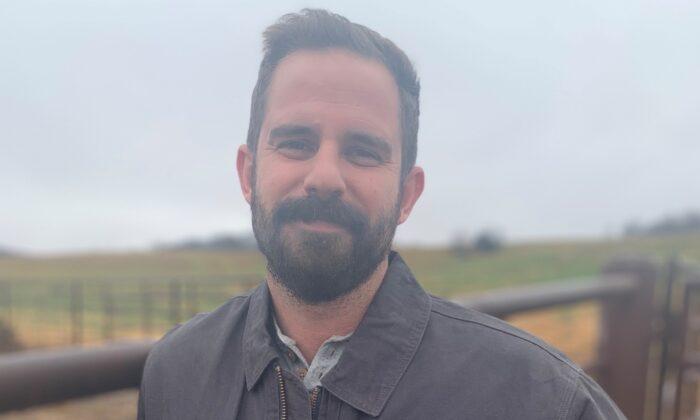Modern technology has made cookware affordable, accessible, and easy to use. Teflon was a modern marvel, and the advent of dishwasher-safe pans a blessing for busy home cooks.
But despite what might be considered progress, we’ve also lost something in the process: the time-honored craft of making traditional copper, cast-iron, and stone cookware, pieces designed with care and built to last.
Many home cooks don’t know how to use and maintain these traditional pieces, and turn to modern options made of aluminum or stainless steel, materials that became popular after World War II, or sprayed with chemical nonstick coatings.
Lest we forget our history, Sara Dahmen, a historical fiction writer and possibly the only working female coppersmith in the country, is reviving these nearly-lost artisanal traditions from the past.

The Coppersmith
Dahmen, 35, is the founder of House Copper and Cookware in Port Washington, Wisconsin. She specializes in handcrafting and restoring traditional cookware, made from all-natural materials and rooted in history.Her recently released book, “Copper, Iron, and Clay: A Smith’s Journey,” details her journey from apprentice to coppersmith, and includes information about the history, science, use, and care of copper, cast-iron, and stone cookware.
“Not only is [my cookware] made in the U.S. completely,” Dahmen said, “but it is also made in the long-lost designs of a time period of the American West, of the fur trade era, right after the colonial time, when we really started to have our own copper and tin industry.”
“I love the way that these pieces of cookware are heirloom, but I also really love preserving knowledge, hence why I write historical fiction,” she said.

Her coppersmithing journey began five years ago, while she was doing research for her second novel “Widow 1881,” based in the Dakota territories in the late 1800s. She realized that much of the cookware of the past had disappeared in modern kitchens, while many home cooks were ordering their cookware online, without knowing what the pieces were made of or who was making them.
One day, despite not having any background in the craft, she decided she would make her own.
From Design to Completion
Each piece of cookware Dahmen makes starts with historical research.Dahmen looks through old texts and photographs to gather information that will be the basis for her own models, and visits museums and historical villages to seek out real-life references for traditional cookware. She adjusts her designs based on her research and then creates her own three-dimensional prototypes for the pieces she wants to make.

After she finalizes her ideal design, she works with a variety of family-owned and -operated businesses in the United States to make the foundation for her pieces.
For her stoneware, Dahmen works with a woman who owns a pottery company that takes the designs, creates prototypes, and crafts the final pieces.
For her cast-iron cookware, Dahmen sends the specs to a foundry, where they pour the metal to create the raw skillets. At this stage, they’re raw and would thus rust within a few days. Dahmen picks up the skillets, dries them out, and presses, sands, and seasons them over large barrel fires in her backyard.
When Dahmen works with copper, her bread and butter, she sends her designs to Ohio, where two men spin the copper into two-dimensional pieces. They then ship these sheets of copper to Dahmen, who sands and grinds handles for each, builds the two-dimensional copper sheets into three-dimensional pieces, and rivets the handles on before placing the pieces over a fire. Finally, she applies tin to the insides of the pieces by hand, before buffing and polishing them into the final products.

The work is loud, hot, and both physically and mentally demanding.
“It is nothing but loud noises,” Dahmen said. “The drill press is loud. The rivet gun is loud. The hammering is loud.”
She wears a full-face gas mask with a carbon canister when she is tinning because the fumes are poisonous. Even when she’s wearing the mask, she can smell the sharp, acrid odor. The smell is so strong she can taste it.
Back to Basics
Dahmen prides herself in making cookware that lasts. The way she sees it, people only need a few pieces of cookware in their kitchen that will last forever.Good-quality cookware also greatly enhances the quality of the meals cooked in them, Dahmen said.
She likes to use stoneware for pies and other baked goods, because the clay, a great insulator, acts like a little oven. It modulates the heat and helps create an even, crispy crust.
She uses her cast-iron as an all-purpose pan for cooking any meats and vegetables but prefers her copper cookware for foods that are easily overcooked, such as shrimp. Copper conducts heat quickly and uniformly, giving the cook more precise control over the cooking temperature.

One of the projects she’s most proud of is a copper jambonniere, a French hand pan large enough to fit an entire pig’s leg for roasting. The piece was a custom order that she made with her veteran tinsmith friend and mentor Bartleme. There was no existing design for the pan, and the only reference they had was two black-and-white photos out of two books in her own library. Nevertheless, they completed the rare piece.
Dahmen believes the history behind cookware like this is especially important today, and wants to bring these traditions of craftsmanship back into the modern kitchen.
“Especially today, in this time of a pandemic, I think that we crave going back to basics more than we realize,” she said. “We need to be cognizant of what we’re cooking on, just as much as we care [about] where our food comes from.”







